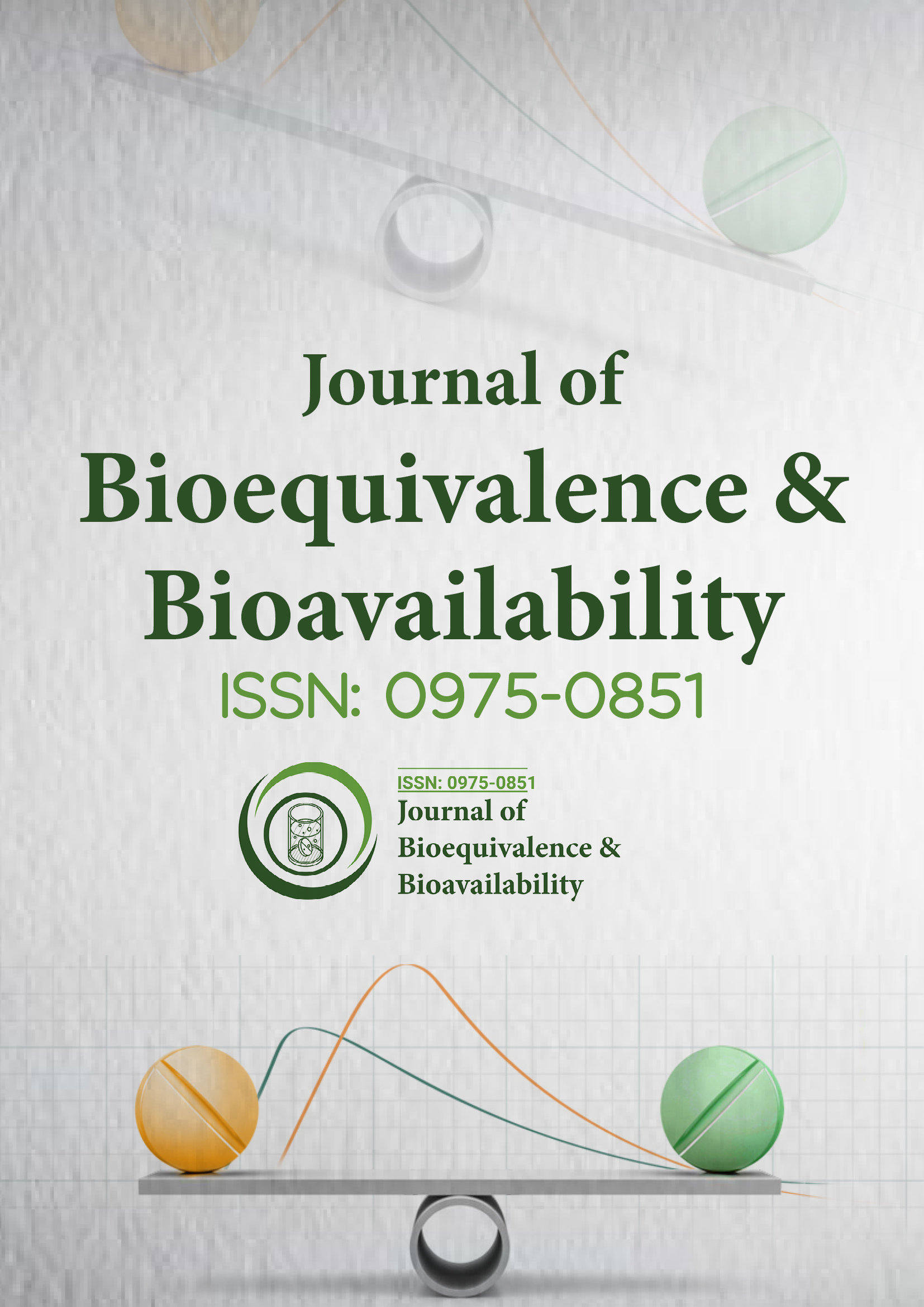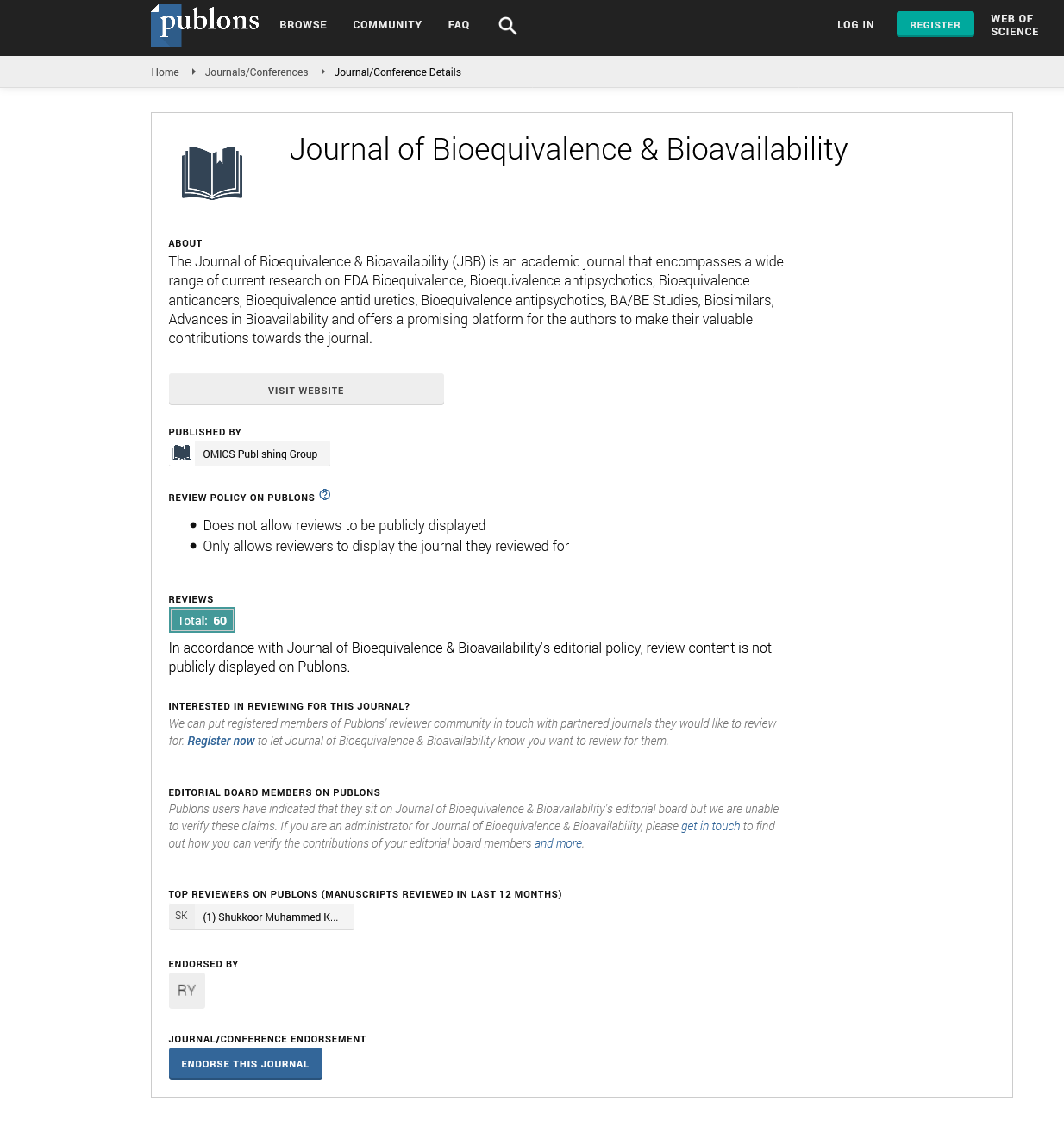Indexed In
- Academic Journals Database
- Open J Gate
- Genamics JournalSeek
- Academic Keys
- JournalTOCs
- China National Knowledge Infrastructure (CNKI)
- CiteFactor
- Scimago
- Ulrich's Periodicals Directory
- Electronic Journals Library
- RefSeek
- Hamdard University
- EBSCO A-Z
- OCLC- WorldCat
- SWB online catalog
- Virtual Library of Biology (vifabio)
- Publons
- MIAR
- University Grants Commission
- Geneva Foundation for Medical Education and Research
- Euro Pub
- Google Scholar
Useful Links
Share This Page
Journal Flyer

Open Access Journals
- Agri and Aquaculture
- Biochemistry
- Bioinformatics & Systems Biology
- Business & Management
- Chemistry
- Clinical Sciences
- Engineering
- Food & Nutrition
- General Science
- Genetics & Molecular Biology
- Immunology & Microbiology
- Medical Sciences
- Neuroscience & Psychology
- Nursing & Health Care
- Pharmaceutical Sciences
Commentary Article - (2025) Volume 17, Issue 1
Advanced In Silico Methods for Predicting Bioequivalence Failures in Generic Drug Development
Sansa Gilbert*Received: 03-Feb-2025, Manuscript No. JBB-24-28938; Editor assigned: 05-Feb-2025, Pre QC No. JBB-24-28938 (PQ); Reviewed: 18-Feb-2025, QC No. JBB-24-28938; Revised: 25-Mar-2025, Manuscript No. JBB-24-28938 (R); Published: 04-Mar-2025, DOI: 10.35248/0975-0851.25.17.619
Description
Generic drug performance in the context of bioequivalence remains one of the most critically evaluated and discussed aspects of pharmaceutical science and regulatory oversight. Generic drugs represent a cornerstone of modern healthcare systems globally by offering more affordable alternatives to brand-name medications. The central tenet underlying their approval and acceptance lies in demonstrating bioequivalence to the innovator or Reference Listed Drug (RLD). In essence, bioequivalence implies that the generic product releases its Active Pharmaceutical Ingredient (API) into the bloodstream at a similar rate and extent as the RLD under comparable conditions. While this definition appears straightforward, the nuances surrounding the actual performance of generic drugs in clinical and real-world settings make it a subject of ongoing inquiry and debate.
Generic drug performance is influenced by several layers of complexity. First, the formulation differences, although deemed pharmaceutically equivalent, can still exhibit subtle variations in excipients, manufacturing processes, and dissolution characteristics. These differences, while not necessarily altering the bioequivalence parameters within the acceptable range, can sometimes lead to variability in patient responses. Particularly in drugs with a Narrow Therapeutic Index (NTI), small fluctuations in drug levels can result in subtherapeutic effects or toxicity, making therapeutic monitoring essential even when bioequivalence is confirmed.
Moreover, generic drug performance must be understood in the context of interchangeability. While all approved generics are deemed bioequivalent, not all are automatically interchangeable. In the U.S., the FDA grants interchangeable status to generics that meet additional criteria, such as evidence from switching studies demonstrating that the product can be substituted without increasing safety risks or reducing efficacy. This distinction is crucial for medications where even slight differences can lead to clinically meaningful outcomes, such as immunosuppressants, antiepileptics, and certain cardiovascular drugs. For these therapeutic areas, performance assurance extends beyond bioequivalence to include therapeutic monitoring and possibly tailored substitution policies.
Internationally, the performance of generic drugs also hinges on the regulatory robustness and enforcement mechanisms in different countries. In regions with well-established regulatory agencies like the EMA, FDA, or Health Canada, the confidence in generic drug quality and performance is high due to stringent approval processes and surveillance systems. However, in low- and middle-income countries, challenges such as limited regulatory capacity, substandard manufacturing practices, and counterfeit products can compromise the performance and reputation of generic drugs. As a result, even when generics are technically bioequivalent, issues in supply chain integrity, storage conditions, or labeling accuracy can erode their performance in the field. Strengthening regulatory harmonization and quality assurance mechanisms is thus essential for ensuring consistent generic drug performance globally.
Technological advancements are playing a transformative role in enhancing the evaluation and prediction of generic drug performance. Tools such as in silico modeling, Physiologically Based Pharmacokinetic (PBPK) simulations, and machine learning algorithms are increasingly being integrated into the drug development and regulatory review process. These tools allow for a more nuanced understanding of how drug formulations will perform across various physiological conditions, age groups, and disease states, thereby extending the confidence in bioequivalence beyond the traditional one-size-fits-all paradigm. They also enable manufacturers to anticipate potential bioequivalence failures during development and optimize formulations accordingly, reducing time and cost while enhancing performance predictability.
In conclusion, generic drug performance in bioequivalence is a multi-dimensional construct that encompasses scientific rigor, regulatory standards, patient perceptions, technological innovation, and real-world application. While the bioequivalence framework provides a solid foundation for ensuring that generics perform similarly to their reference counterparts, evolving patient demographics, complex drug formulations, and emerging health technologies call for ongoing refinement of evaluation methodologies. Maintaining the trust of healthcare providers and patients hinges on transparency, consistent quality, and evidence-based policies. As generic drugs continue to play an indispensable role in global health, ensuring their performance through advanced science, robust regulation, and proactive engagement will remain a top priority for the pharmaceutical community.
Citation: Gilbert S (2025). Advanced In Silico Methods for Predicting Bioequivalence Failures in Generic Drug Development. J Bioequiv Availab. 17:619.
Copyright: © 2025 Gilbert S. This is an open-access article distributed under the terms of the Creative Commons Attribution License, which permits unrestricted use, distribution, and reproduction in any medium, provided the original author and source are credited.

